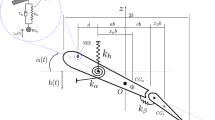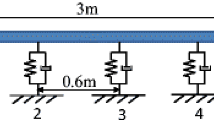Abstract
Dynamical systems often exhibit limit cycle oscillations (LCOs), self-sustaining oscillations of limited amplitude. LCOs can be supercritical or subcritical. The supercritical response is benign, while the subcritical response can be bi-stable and exhibit a hysteretic response. Subcritical responses can be avoided in design optimization by enforcing LCO stability. However, many high-fidelity system models are computationally expensive to evaluate. Thus, there is a need for an efficient computational approach that can model instability and handle hundreds or thousands of design variables. To address this need, we propose a simple metric to determine the LCO stability using a fitted bifurcation diagram slope. We develop an adjoint-based formula to efficiently compute the stability derivative with respect to many design variables. To evaluate the stability derivative, we only need to compute the time-spectral adjoint equation three times, regardless of the number of design variables. The proposed adjoint method is verified with finite differences, achieving a five-digit agreement between the two approaches. We consider a stability-constrained LCO parameter optimization problem using an analytic model to demonstrate that the optimizer can suppress the instability. We also consider a more realistic LCO speed and stability-constrained airfoil problem that minimizes the normalized mass and stiffness. The proposed method could be extended to optimization problems with a partial differential equation (PDE)-based model, opening the door to other applications where high-fidelity models are needed.









Similar content being viewed by others
Data Availability Statement
The numerical implementation of algorithms and results discussed in this work are available in the form of open-source Python software at DOI:10.5281/zenodo.5992080.
References
Strogatz, S.H.: Nonlinear Dynamics and Chaos: With Applications to Physics, Biology, Chemistry, and Engineering. Perseus books, Reading, Massachusetts (1994)
He, S., Jonsson, E., Mader, C.A., Martins, J.R.R.A.: Aerodynamic shape optimization with time spectral flutter adjoint. In: 2019 AIAA/ASCE/AHS/ASC Structures, Structural Dynamics, and Materials Conference. American Institute of Aeronautics and Astronautics, San Diego, CA (2019a)
Huang, D., Rokita, T., Friedmann, P.P.: Integrated aerothermoelastic analysis framework with application to skin panels. AIAA J. 56(11), 4562–4581 (2018)
Jonsson, E., Riso, C., Lupp, C.A., Cesnik, C.E.S., Martins, J.R.R.A., Epureanu, B.I.: Flutter and post-flutter constraints in aircraft design optimization. Progress Aerospace Sci. 109(100), 537 (2019)
Li, H., Ekici, K.: Aeroelastic modeling of the AGARD 445.6 wing using the harmonic-balance-based one-shot method. AIAA J. 57(11), 4885–4902 (2019)
Riso, C., Ghadami, A., Cesnik, C.E.S., Epureanu, B.I.: Data-driven forecasting of postflutter responses of geometrically nonlinear wings. AIAA J. 58(6), 2726–2736 (2020)
Thomas, J.P., Dowell, E.H., Hall, K.C.: Nonlinear inviscid aerodynamic effects on transonic divergence, flutter, and limit-cycle oscillations. AIAA J. 40(4), 638–646 (2002)
Grizzle, J., Abba, G., Plestan, F.: Asymptotically stable walking for biped robots: analysis via systems with impulse effects. IEEE Trans. Autom. Control 46(1), 51–64 (2001)
Manchester, I.R., Tobenkin, M.M., Levashov, M., Tedrake, R.: Regions of attraction for hybrid limit cycles of walking robots. IFAC Proc. Volume. 44(1), 5801–5806 (2011)
Shiriaev, A., Freidovich, L., Manchester, I.: Can we make a robot ballerina perform a pirouette? orbital stabilization of periodic motions of underactuated mechanical systems. Ann. Rev. Control 32(2), 200–211 (2008)
Waugh, I.C., Kashinath, K., Juniper, M.P.: Matrix-free continuation of limit cycles and their bifurcations for a ducted premixed flame. J. Fluid Mech. 759, 1–27 (2014)
Xu, M., Song, S., Sun, X., Chen, W., Zhang, W.: Machine learning for adjoint vector in aerodynamic shape optimization. (2020) arXiv preprint arXiv:2012.15730
He, S., Jonsson, E., Martins, J.R.R.A.: Wing aerostructural optimization with time spectral limit-cycle oscillation adjoint. In: AIAA AVIATION 2022 Forum (2022)
Lyu, Z., Xu, Z., Martins, J.R.R.A.: Benchmarking optimization algorithms for wing aerodynamic design optimization. In: Proceedings of the 8th International Conference on Computational Fluid Dynamics, Chengdu, Sichuan, China, iCCFD8-2014-0203 (2014)
Martins, J.R.R.A., Ning, A.: Engineering Design Optimization. Cambridge University Press, Cambridge (2021)
Jameson, A.: Aerodynamic design via control theory. J. Sci. Comput. 3(3), 233–260 (1988)
Kenway, G.K.W., Kennedy, G.J., Martins, J.R.R.A.: Scalable parallel approach for high-fidelity steady-state aeroelastic analysis and adjoint derivative computations. AIAA J. 52(5), 935–951 (2014)
Kenway, G.K.W., Mader, C.A., He, P., Martins, J.R.R.A.: Effective adjoint approaches for computational fluid dynamics. Progress Aeros. Sci. 110(100), 542 (2019)
Shi, Y., Mader, C.A., He, S., Halila, G.L.O., Martins, J.R.R.A.: Natural laminar-flow airfoil optimization design using a discrete adjoint approach. AIAA J. 58(11), 4702–4722 (2020)
Thomas, J.P., Dowell, E.H.: Discrete adjoint approach for nonlinear unsteady aeroelastic design optimization. AIAA J. 57, 4368–4376 (2019)
Lasagna, D.: Sensitivity analysis of chaotic systems using unstable periodic orbits. SIAM J. Appl. Dyn. Syst. 17(1), 547–580 (2018)
Shimizu, YS., Fidkowski, K.: Output error estimation for chaotic flows. In: 46th AIAA Fluid Dynamics Conference, American Institute of Aeronautics and Astronautics (2016)
Wang, Q.: Forward and adjoint sensitivity computation of chaotic dynamical systems. J. Comput. Phys. 235, 1–13 (2013)
Wilkins, A.K., Tidor, B., White, J., Barton, P.I.: Sensitivity analysis for oscillating dynamical systems. SIAM J. Sci. Comput. 31(4), 2706–2732 (2009)
Chicone, C.: Ordinary Differential Equations with Applications. Springer, New York (2006)
Floquet, G.: Sur les équations différentielles linéaires à coefficients périodiques. Ann. Scientifiques de l’École normale supérieure 12, 47–88 (1883)
Friedmann, P., Hammond, C.E., Woo, T.H.: Efficient numerical treatment of periodic systems with application to stability problems. Int. J. Numerical Methods Eng. 11(7), 1117–1136 (1977)
Dimitriadis, G.: Continuation of higher-order harmonic balance solutions for nonlinear aeroelastic systems. J. Aircr. 45(2), 523–537 (2008)
Shukla, H., Patil, M.J.: Nonlinear state feedback control design to eliminate subcritical limit cycle oscillations in aeroelastic systems. Nonlinear Dyn. 88(3), 1599–1614 (2017)
Gai, G., Timme, S.: Nonlinear reduced-order modelling for limit-cycle oscillation analysis. Nonlinear Dyn. 84(2), 991–1009 (2016)
Habib, G., Kerschen, G.: Suppression of limit cycle oscillations using the nonlinear tuned vibration absorber. Proc. Royal Soc. A Math. Phys. Eng. Sci. 471(2176), 20140976 (2015)
Kuznetsov, Y.A.: Elements of applied bifurcation theory. Applied mathematical sciences, Springer, New York, NY (2010)
Malher, A., Touzé, C., Doaré, O., Habib, G., Kerschen, G.: Flutter control of a two-degrees-of-freedom airfoil using a nonlinear tuned vibration absorber. J. Comput. Nonlinear Dyn. 12(5), 016–051 (2017)
Stanford, B., Beran, P.: Direct flutter and limit cycle computations of highly flexible wings for efficient analysis and optimization. J. Fluids Struct. 36, 111–123 (2013)
Bauchau, O.A., Nikishkov, Y.G.: An implicit Floquet analysis for rotorcraft stability evaluation. J. Am. Helicopter Soc. 46(3), 200 (2001)
Cao, Y., Li, S., Petzold, L., Serban, R.: Adjoint sensitivity analysis for differential-algebraic equations: the adjoint DAE system and its numerical solution. SIAM J. Sci. Comput. 24(3), 1076–1089 (2003)
Seyranian, A., Solem, F., Pedersen, P.: Sensitivity analysis for the floquet multipliers. In: 2000 2nd International Conference. Control of Oscillations and Chaos. Proceedings (Cat. No.00TH8521), IEEE (2000)
Shukla, H., Patil, M.J.: Controlling limit cycle oscillation amplitudes in nonlinear aeroelastic systems. J. Aircraft 54(5), 1921–1932 (2017)
Riso, C., Cesnik, CES., Epureanu, BI., Teufel, P.: A post-flutter response constraint for gradient-based aircraft design optimization. In: AIAA Aviation 2021 Forum, American Institute of Aeronautics and Astronautics (2021)
Stanford, B., Beran, P., Kurdi, M.: Adjoint sensitivities of time-periodic nonlinear structural dynamics via model reduction. Comput. Struct. 88(19–20), 1110–1123 (2010)
He, S., Jonsson, E., Mader, CA., Martins, J.R.R.A.: A coupled Newton–Krylov time-spectral solver for wing flutter and LCO prediction. In: AIAA Aviation Forum, Dallas, TX (2019b)
He, S., Jonsson, E., Mader, C.A., Martins, J.R.R.A.: Coupled Newton-Krylov time-spectral solver for flutter and limit cycle oscillation prediction. AIAA J. 59(6), 2214–2232 (2021)
Virtanen, P., Gommers, R., Oliphant, T.E., Haberland, M., Reddy, T., Cournapeau, D., Burovski, E., Peterson, P., Weckesser, W., Bright, J., van der Walt, S.J., Brett, M., Wilson, J., Millman, K.J., Mayorov, N., Nelson, A.R.J., Jones, E., Kern, R., Larson, E., Carey, C.J., Polat, I., Feng, Y., Moore, E.W., VanderPlas, J., Laxalde, D., Perktold, J., Cimrman, R., Henriksen, I., Quintero, E.A., Harris, C.R., Archibald, A.M., Ribeiro, A.H., Pedregosa, F., van Mulbregt, P.: SciPy 1.0: fundamental algorithms for scientific computing in python. Nat. Methods 17(3), 261–272 (2020)
Knoll, D.A., Keyes, D.E.: Jacobian-free Newton-Krylov methods: a survey of approaches and applications. J. Comput. Phys. 193(2), 357–397 (2004)
Yildirim, A., Kenway, G.K.W., Mader, C.A., Martins, J.R.R.A.: A Jacobian-free approximate Newton-Krylov startup strategy for RANS simulations. J. Comput. Phys. 397(108), 741 (2019)
Gill, P.E., Murray, W., Saunders, M.A.: SNOPT: an SQP algorithm for large-scale constrained optimization. SIAM J. Opt. 12(4), 979–1006 (2002)
Wu, N., Kenway, G., Mader, C.A., Jasa, J., Martins, J.R.R.A.: PyOptSparse: a Python framework for large-scale constrained nonlinear optimization of sparse systems. J. Open Source Softw. 5(54), 2564 (2020)
Acknowledgements
The authors thank Cristina Riso for the helpful technical discussions of the work.
Author information
Authors and Affiliations
Corresponding author
Ethics declarations
Conflict of interest
The authors declare that they have no conflict of interest.
Additional information
Publisher's Note
Springer Nature remains neutral with regard to jurisdictional claims in published maps and institutional affiliations.
Rights and permissions
Springer Nature or its licensor (e.g. a society or other partner) holds exclusive rights to this article under a publishing agreement with the author(s) or other rightsholder(s); author self-archiving of the accepted manuscript version of this article is solely governed by the terms of such publishing agreement and applicable law.
About this article
Cite this article
He, S., Jonsson, E. & Martins, J.R.R.A. Adjoint-based limit cycle oscillation instability sensitivity and suppression. Nonlinear Dyn 111, 3191–3205 (2023). https://doi.org/10.1007/s11071-022-07989-0
Received:
Accepted:
Published:
Issue Date:
DOI: https://doi.org/10.1007/s11071-022-07989-0




